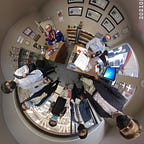A Local Moral World
It isn’t surprising how everyone we’ve encountered throughout our lives exhibits a unique array of values and characteristics which demonstrate the embodiment of an individual’s lived experiences and phenomenology. Our cultural upbringing shapes the beliefs and decisions we make daily, our perception of ourselves and others, and what’s considered right and wrong (cognitive and neuropsychological assessment). For instance, professor Sloane observes Marcel Mauss’ text “Technique of the Body” attempting diverse postures and gestures adopted by “how culturally influential the development of our bodily experience was” (Sloane Lecture #15). She provides an example in Micronesia, as it would disrespectful to approach an individual and look them in the eye, while in America it would be considered culturally impolite to not look at someone in the eye (Sloane Lecture #15). Instances as such demonstrate how our local moral world can directly influence health and psychological experiences and “objectify” inner psychological distress or emotional experience in a culturally-constructed behavior through self-transformation/development of religious experiences and the acquisition of a specialized cultural role. Therefore, the local moral world is significantly influenced by an individual’s cultural background, how they may objectify, and if the individual believes in the objectification under one’s process of self-transformation in religious experiences, and the acquisition of a specialized cultural role.
To start, self-transformation and development are routinely observed in every individual coming in many forms such as an opportunity to invent, involve oneself in a conversation, or make a commitment for the goal to discover one’s full potential. This can come in many areas such as academics, career, mentally, and emotionally. More specifically, this form of self-transformation is widely practiced in a convent where it “arranges its elements of selfhood in relation to each other. . .the material body and facilitates guided ‘working through’. . .within a particular system of meaning, of the metaphysical problematics involved (Sloane Lecture #14). The inside-out process demonstrates a method of self-transformation comprising first breaking the cycle to become habituated into a new way of experiencing moment to moment of the world. In religious experiences, phenomenologically your body would be motivated to pray and challenge the temptation to do what you’ve previously done. This element of self-control can extend further to actions of consistent prayer or confession to a priest, which can craft the version of yourself you want to be, tying into the “objecti[fication]” of oneself.
At a young age, our culturally-constructed initial behaviors were developed under the template of our parents or caregivers, like role models. In the convent, the idea of self-transformation is practiced by challenging our initial behaviors by following and embodying one’s ideal self through a priest or nun. When individuals “objectify” their inner psychological distress or emotional experiences in a culturally-constructed behavior through religious experiences, they are expressing their private emotions in a public idiom by attending church or confessing to a priest. Many mental and emotional issues are being objectified as a sorcery attack or an act of spirit possession which is recognized as a pathological experience that needs healing through the priest or nun (Sloane Lecture #14). Individuals “objectify” their symptoms or behaviors as culturally-constituted defense mechanisms, indicative of an experience or source of being attacked. For example, many religious practices can include engaging in many prayers, sacrificing a chicken to a deity, or paying money to a shrine. These forms of spiritual healing may be beneficial in methods to heal the internal spirit possession (Sloane Lecture #14). Therefore, the local moral world also significantly influences the health and psychological experience of a person depending on the individual’s cultural background, how they may objectify, and if the individual believes in the objectification. Moreover, this is well emphasized in “Dava and Dua” where people in Gujarat, Western India would go on pilgrimages in hopes to receive spiritual healing after being possessed by a sorcerer or evil spirit (Basu, 2014). Thomas Csordas distinguishes the religious healing practices of Catholic Pentecostals observing “how each system starts from a phenomenological analysis of preobjective experiences that are turned into distinct abstraction or cultural objectification” (Basu, 2014). Csordas’ research demonstrates the healing effects of the shrine “Mira Datar” and how objectification based on one’s cultural upbringing, community, and family is crucial in experiencing afflictions of sorcery, possession, and healing influencing the health and psychological experiences of the individual (Basu, 2014).
Work Cited
Basu, Helene. 2014. “Dava and Dua: Negotiating Psychiatry and Ritual Healing of Madness.” In Asymmetrical conversations: Contestations, circumventions, and the blurring of therapeutic boundaries.
Edited by Harish Naraindas, Johannes Quack, and William S. Sax. Berghahn Books: 162–199. Boas, Franz. 1887. A Year among the Eskimo. Journal of the American Geographical Society of New York 19: 383–402.
Csordas, Thomas J. 1990. Embodiment as a Paradigm for Anthropology. Ethos 18(1): 5–47. Finke, Peter and Martin Sökefeld. 2018. “Identity in anthropology.” In The International Encyclopedia of Anthropology: 1–13.
Sloane, Julia. 2022. Lecture #14
Sloane, Julia. 2022. Lecture #15
